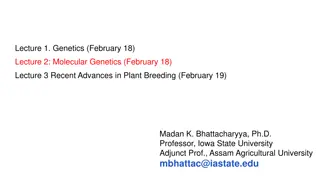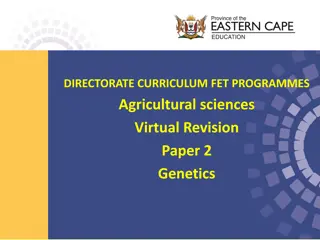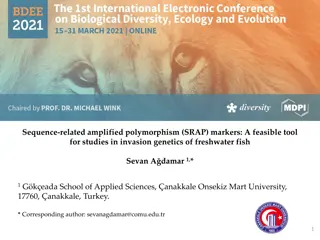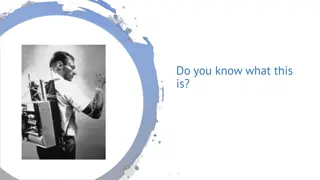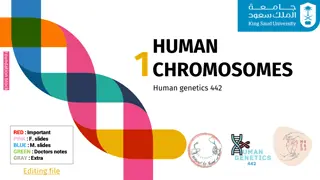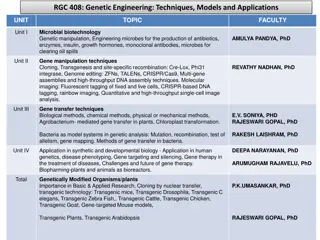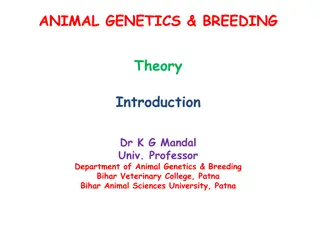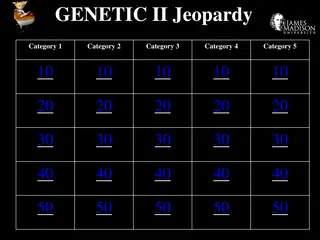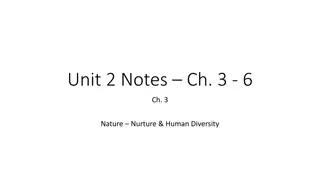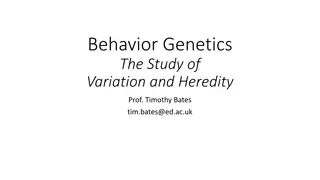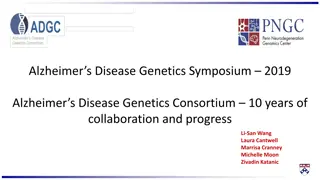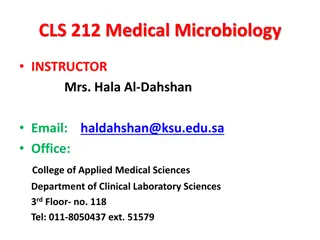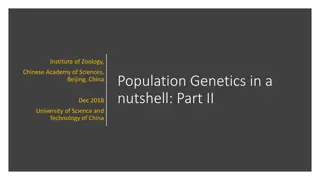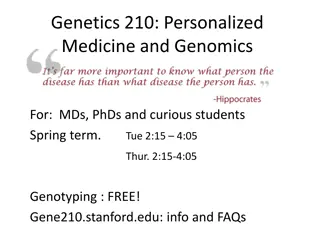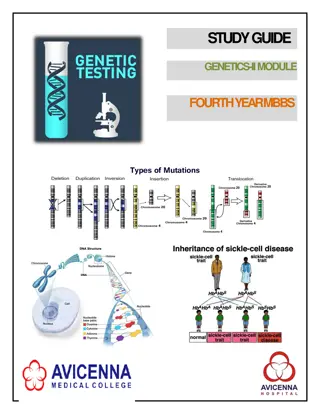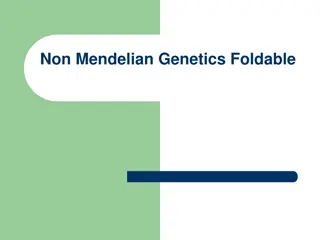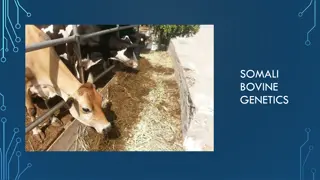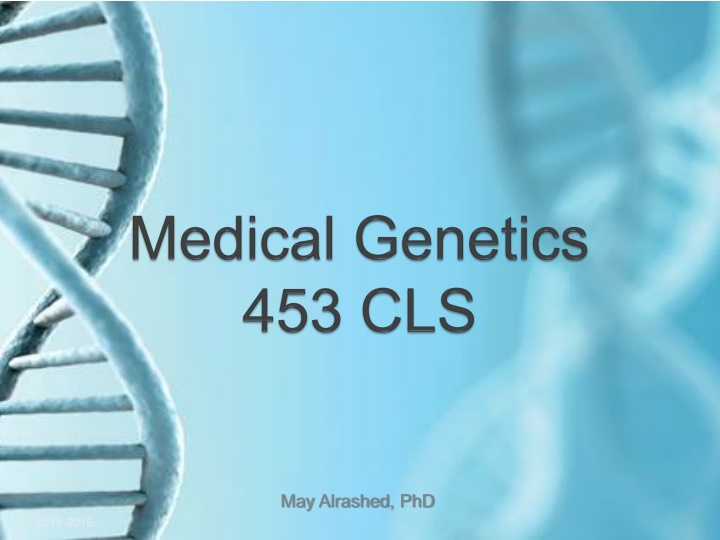
Chromosome and DNA Structure
Explore the fundamental concepts of chromosomes and DNA structure explained by May Alrashed, PhD, including chromosome types, organization, and the composition of DNA molecules and nucleotides.
Download Presentation

Please find below an Image/Link to download the presentation.
The content on the website is provided AS IS for your information and personal use only. It may not be sold, licensed, or shared on other websites without obtaining consent from the author. If you encounter any issues during the download, it is possible that the publisher has removed the file from their server.
You are allowed to download the files provided on this website for personal or commercial use, subject to the condition that they are used lawfully. All files are the property of their respective owners.
The content on the website is provided AS IS for your information and personal use only. It may not be sold, licensed, or shared on other websites without obtaining consent from the author.
E N D
Presentation Transcript
May Alrashed, PhD 2015-2016
2015-2016 May Alrashed, PhD
What is a chromosome? Chromosome Structure made of DNA and associated proteins Carries part or all of a cell s genetic information A human body cell has 23 pairs of chromosomes Diploid Cells having two of each type of chromosome characteristic of the species (2n). 2015-2016 May Alrashed, PhD
Types of Chromosomes There are two types of eukaryotic chromosomes: autosomes and sex chromosomes Autosomes Paired chromosomes with the same length, shape, centromere location, and genes Any chromosome other than a sex chromosome (Human- 22 pair) Sex chromosomes a pair of chromosomes that differ between males and females (XX or XY) 2015-2016 May Alrashed, PhD
Chromosome Structure Proteins organize DNA structurally Allow chromosomes to pack tightly Histone Type of protein that structurally organizes eukaryotic chromosomes Nucleosome A length of DNA wound around a coil of histone proteins 2015-2016 May Alrashed, PhD
Structure of a chromosome Sister chromatid One of two attached members of a duplicated eukaryotic chromosome Centromere Constricted region in a eukaryotic chromosome where sister chromatids are attached 2015-2016 May Alrashed, PhD
DNA Structure DNA consists of two molecules that are arranged into a ladder-like structure called a Double Helix. A molecule of DNA is made up of millions of tiny subunits called Nucleotides. Each nucleotide consists of: 1. Phosphate group 2. Pentose sugar 3. Nitrogenous base 2015-2016 May Alrashed, PhD
Nucleotides Phosphate Nitrogenous Base Pentose Sugar 2015-2016 May Alrashed, PhD
Nucleotides The phosphate and sugar form the backbone of the DNA molecule, whereas the bases form the rungs . 2015-2016 May Alrashed, PhD
Nucleotides There are four types of nitrogenous bases. A A T Adenine Thymine G G C C Guanine Cytosine 2015-2016 May Alrashed, PhD
Nucleotides Each base will only bond with one other specific base. Adenine (A) Thymine (T) Form a base pair. Cytosine (C) Guanine (G) Form a base pair. Because of this complementary base pairing, the order of the bases in one strand determines the order of the bases in the other strand. 2015-2016 May Alrashed, PhD
A A T G G C C T A A G G C C A A T G G C C T A A 2015-2016 May Alrashed, PhD
DNA Structure To crack the genetic code found in DNA we need to look at the sequence of bases. The bases are arranged in triplets called codons. A G G - C T C - A A G - T C C - T A G T C C - G A G - T T C - A G G - A T C 2015-2016 May Alrashed, PhD
DNAStructure A gene is a section of DNA that codes for a protein. Each unique gene has a unique sequence of bases. This unique sequence of bases will code for the production of a unique protein. It is these proteins and combination of May Alrashed, PhD proteins that give us a unique phenotype. 2015-2016
DNA Gene Protein Trait 2015-2016 May Alrashed, PhD
Your Task Draw a flow chart to show how to get from: 2015-2016 May Alrashed, PhD
DNA Replication and Repair During DNA replication, the double-helix unwinds DNA polymerase uses each strand as a template to assemble new, complementary strands of DNA from free nucleotides DNA ligase (enzyme) seals any gaps to form a continuous strand 2015-2016 May Alrashed, PhD
Steps of DNA Replication 1. First step is the breaking of hydrogen bonds between bases of the two antiparallel strands. Helicase is the enzyme that splits the two strands. The initiation point where the splitting starts is called "origin of replication". The structure that is created is known as "Replication Fork". 2015-2016 May Alrashed, PhD
2. binding of RNA Primase in the the initiation point of the 3'-5' parent chain. RNA Primase can attract RNA nucleotides which bind to the DNA nucleotides of the 3'-5' strand due to the hydrogen bonds between the bases. 3. The elongation process is different for the 5'- 3' and 3'-5' template. a)5'-3' Template: The 3'-5' proceeding daughter strand that uses a 5'-3' template is called leading strand because DNA Polymerase can "read" the template and continuously adds nucleotides b)3'-5'Template: The 3'-5' template cannot be "read" by DNA Polymerase . The replication of this template is complicated and the new strand is called lagging strand. In the lagging strand the RNA May Alrashed, PhD Primase adds more RNA Primers. 2015-2016
In the lagging strand the DNA Pol I - exonuclease- reads the fragments and removes the RNA Primers. The gaps are closed with the action of DNA Polymerase. Each new double helix is consisted of one old and one new chain. so it is called semiconservative replication. 2015-2016 May Alrashed, PhD
The last step of Replication is the Termination. - the DNA Polymerase reaches the end of the strands. In the lagging strand, when the RNA primer is removed, it is not possible for the DNA Polymerase to seal the gap (because there is no primer). So, the end of the parental strand where the last primer binds isn't replicated. These ends of linear (chromosomal) DNA consists of noncoding DNA that contains repeat sequences and are called telomeres. As a result, a part of the telomere is removed in every cycle of DNA Replication. 2015-2016 May Alrashed, PhD
Mechanism of Replication 2015-2016 May Alrashed, PhD
DNA Repair mechanism Repair mechanism fixes possible errors caused during the replication. Enzymes like nucleases remove the wrong nucleotides and the DNA Polymerase fills the gaps. 2015-2016 May Alrashed, PhD
2015-2016 May Alrashed, PhD



